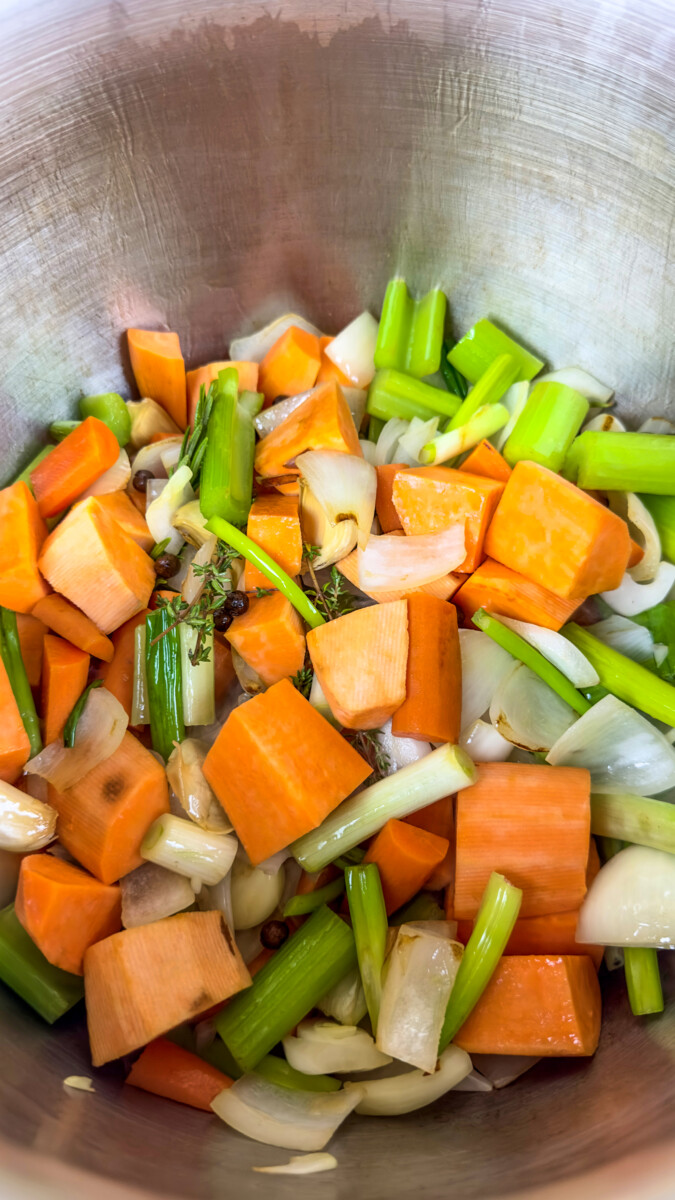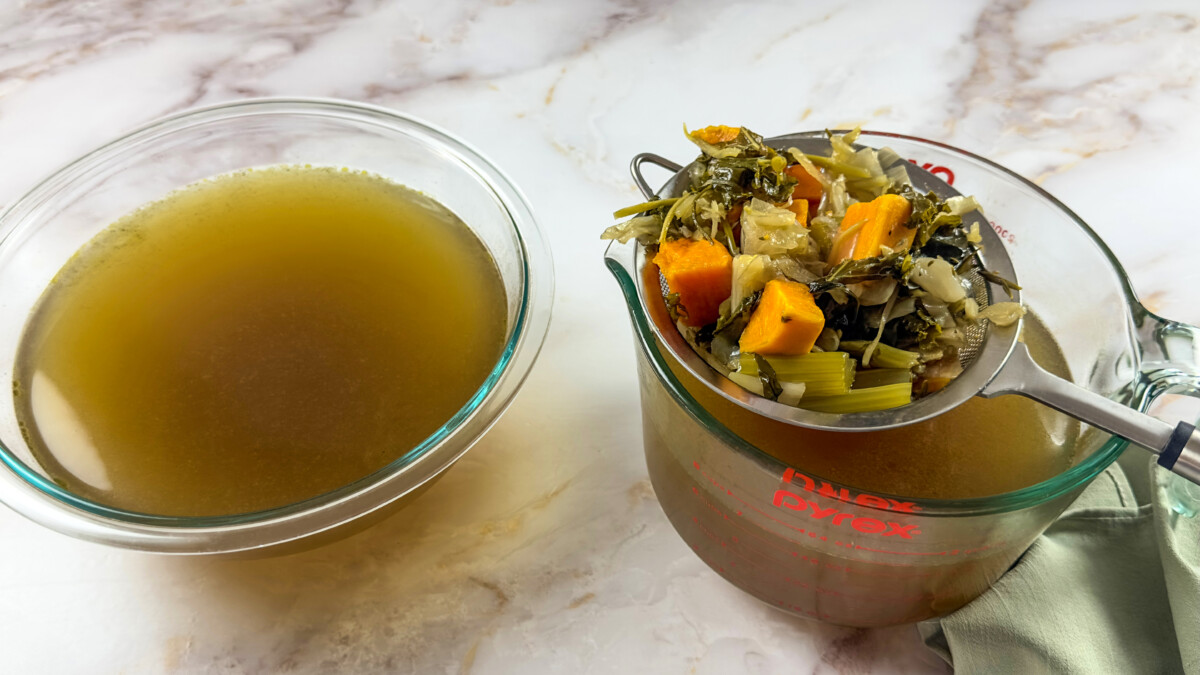Welcome to the world of homemade cooking with our easy-to-make and tasty vegetable broth! This broth is not just healthy, but it can be used in so many dishes. It can also be enjoyed just as it is. Let’s get started on making this key kitchen ingredient
Table of Contents
Homemade vegetable broth might not be the flashiest dish, but it’s an essential skill everyone should hone. This broth is the backbone of countless delectable soups and various recipes. It is an excellent natural remedy for those not feeling their best, especially when crafted from wholesome, organic ingredients.
Health and wellness are the cornerstones of my approach to cooking. That’s why I often opt for a vegetable broth low sodium version, given that 90% of the ingredients in this recipe are organic. Filtered water is my go-to, and I generally forego adding salt. However, for those who enjoy an extra pinch of flavor, or if you’re in a hurry and resort to a vegetable broth can, feel free to season it according to your preference. Read more about the importance of stocks in Mediterranean cuisine.
Key Ingredients for Your Homemade Vegetable Broth:
- Celery: Adds a savory, earthy flavor with a mild bitterness.
- Carrots: Bring a subtle sweetness and a slightly earthy taste.
- Sweet Potatoes: Contribute a hint of natural sweetness and a starchy depth.
- Onions: Provide a strong, aromatic, and somewhat sweet flavor.
- Green Onions: Add a mild onion flavor with a touch of freshness.
- Garlic: Introduces a pungent, aromatic, and slightly spicy note.
- Fresh Rosemary: Infuses a woody, pine-like fragrance with earthy undertones.
- Fresh Thyme: Offers a delicate, herbal, and slightly minty flavor.
- Italian Parsley: Provides a fresh, bright, and slightly peppery taste.
- Leafy Greens (e.g., Kale, Collards, Broccoli Leaves): Enhance the broth with a leafy, vegetal essence.
- Filtered Water: Serves as the liquid base and carries the flavors of the ingredients.
- Olive Oil: Adds a subtle, fruity richness to the broth.
- Black Peppercorns: Provide a gentle spiciness and a touch of heat.
Together, these ingredients create a well-balanced and flavorful vegetable broth that can elevate the taste of various dishes.
Homemade Broth vs Store-bought
While the convenience of store-bought vegetable broth is tempting, it’s essential to weigh the trade-offs. Many canned broths, even those labeled as healthy, can contain unnecessary additives and excessive salt. This not only masks the genuine vegetable flavors but may also affect your well-being.
Opting for homemade vegetable broth introduces a richer culinary experience. Making broth from vegetable scraps means less waste and full utilization of every vegetable component. The transition from store-bought to homemade elevates you from a mere cook to a curator, diligently choosing organic ingredients for your broth. Such a homemade approach offers unmatched flavor flexibility—be it a quick soup or a slow-simmered broth—and a wealth of nutrients. This choice goes beyond taste; it’s about infusing every dish with wholesome goodness.
Tips for Perfect Broth
The quality of your ingredients plays a significant role. Seasonal vegetables offer peak flavors, so let the seasons guide your choices. Herbs and spices can dramatically influence your broth’s taste profile, so experiment to find what resonates with you. And remember to avoid pitfalls like over-salting, which can turn a homemade broth into a high-sodium dish.
Versatile Uses of Broths
With its vibrant flavors and health benefits, homemade vegetable broth can transform many dishes beyond traditional vegetable soup. This broth introduces complexity without relying on meat-based alternatives by adding depth to grains and stews or acting as a vital component in vegan recipes.
Whether it’s the wholesome goodness of Lentil Kale Soup, the rich embrace of Carrot Coconut and vegan Cream of Mushroom, or the fresh vibrancy of Broccoli and Butternut Squash soups, our offerings, both vegetarian and vegan, are a testament to the culinary magic unlocked by a well-made broth.Check out my soup collection.
However, as enriching as our vegetable broth is, it represents just one hue in the colorful spectrum of broths. A nutrient-rich lamb broth, for instance, brings its own set of unique flavors and benefits. Further diving into the culinary world and exploring the nuances distinguishing broth from stock is intriguing. While the gelatinous depth of stocks owes itself to simmered bones, broths maintain a lighter consistency, achieved by simmering meat or vegetables.
Preparation

Melt one tablespoon of coconut oil over medium heat in a large stockpot.


After the first hour of simmering, add an additional cup of warm water. This helps to ensure all the flavors are fully extracted from the vegetables. Repeat this step after the second hour.


Now, you're ready to enhance your cooking with your very own homemade vegetable broth. Enjoy!
Ingredients:
Adjust Servings
| 5 celery sticks (cut into large chunks) | |
| 5 carrots (cut into large chunks) | |
| 2 sweet potatoes (peeled and cut into large chunks ) | |
| 1 large onion (cut into large chunks) | |
| 1 bunch green onions (chopped) | |
| 5 garlic cloves (not peeled) | |
| 3 twigs fresh rosemary | |
| 3 twigs fresh thyme | |
| ½ bunch Italian parsley | |
| 1 bunch greens like kale and collards (I used broccoli leaves) | |
| 20 cups filtered water | |
| 1 tablespoon olive oil or coconut oil | |
| 10 black peppercorns |
Preparation
Recipe Tips & Suggestions
Storing Vegetable Broth?
Freezing Homemade Vegetable Broth:
Rana’s Notes!
Nutrition Information
The information shown is an estimate provided by an online nutrition calculator. It should should not be considered a substitute for a professional nutritionist's advice.
See our full nutrition disclosure here.







I would love to hear your experience!